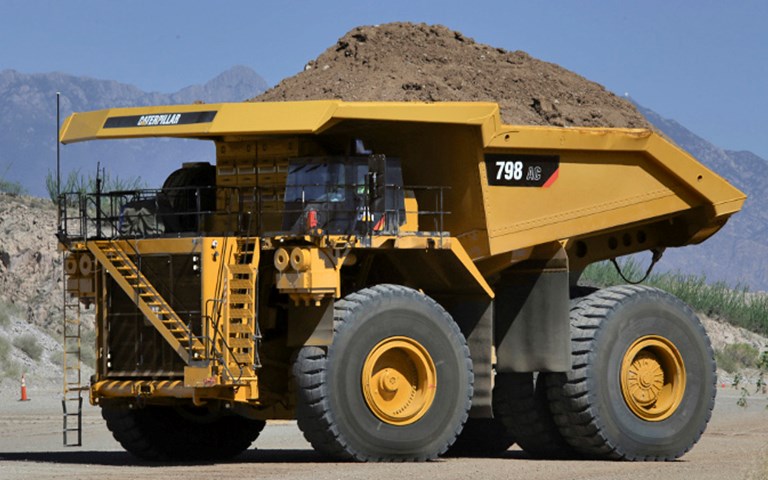Caterpillar's 798 AC mining truck at the company's Arizona proving grounds near Tucson. Courtesy of Caterpillar
Caterpillar unveiled two new models to add to its line of large mining trucks with electric drives – the 326-tonne 796 AC and the high tonnage 798 AC heavy hauler that can carry up to 373 tonnes.
While the 796 is not yet in production, a pair of 798s have been at work for the last six months at a mine in Wyoming. Both models meet the strict Tier 4 emissions standards for particulate matter and nitrogen oxide that came into effect in Canada at the beginning of 2018.
“The most important thing is for us to be able to give our customers options,” said product performance manager John Ingle at a product rollout for media at the company’s Tinaja Hills Demonstration and Training Center south of Tucson, Arizona last week.
Caterpillar did not offer any electric drive options until 2011, when it picked up the Unit Rig line of trucks with its acquisition of Bucyrus. That truck, since relaunched as the 794 AC, has been updated with entirely Cat-sourced parts, and was the inspiration for the two larger models. Key elements, such as the frame, chassis and mechanic–friendly modular design, were adapted to the larger trucks.
Related: ArcelorMittal worked with Caterpillar on a partial autonomous drilling system at its Mont-Wright mine
The 798 AC model is lighter than the mechanical drive 797, but can match the payload of Cat’s largest hauler, the 797F, which is a fixture in Alberta’s oil sands operations. The 796 AC is meant to replace the 795 AC in jurisdictions such as Canada and the United States where emission standards are especially strict. Both trucks will be available in the spring of 2019.
Other features on the new models include four corner, oil-cooled disc brakes; dynamic breaking and the ability to tweak the power output of the truck to ease its integration into the larger operating fleet.
The manufacturer also used the event to show off its expanding options of autonomous-ready haulers. Items such as anti-lock brake infrastructure, harnessing for additional wiring and mounting plates for Cat’s Command for hauling system will be standard on the 181-tonne 789D as it currently is with the 793F, in response to demands from miners. “New greenfields projects all include an autonomous component for the large class trucks,” said Craig Watkins, the company’s mining technology commercial manager. A truck being outfitted for auto hauling is a truck not producing, which is a major cost to mine operators. Watkins said this autonomous-ready design can cut the time required to make the switch by half, so the manufacturer will work its way through its roster of trucks from the highest capacity downward to incorporate these features into the production process.
Currently, 793F trucks are running autonomously using the Command system at FMG operations in Western Australia and on a smaller scale at Teck Resources' Highland Valley Copper in British Columbia, and 797F trucks are using the system at Imperial Oil’s Kearl oil sands mine. According to Watkins, this technology is providing a 20 per cent-productivity improvement due to factors such as the average higher speed they operate at and that there is no interruption to production during shift changes.



